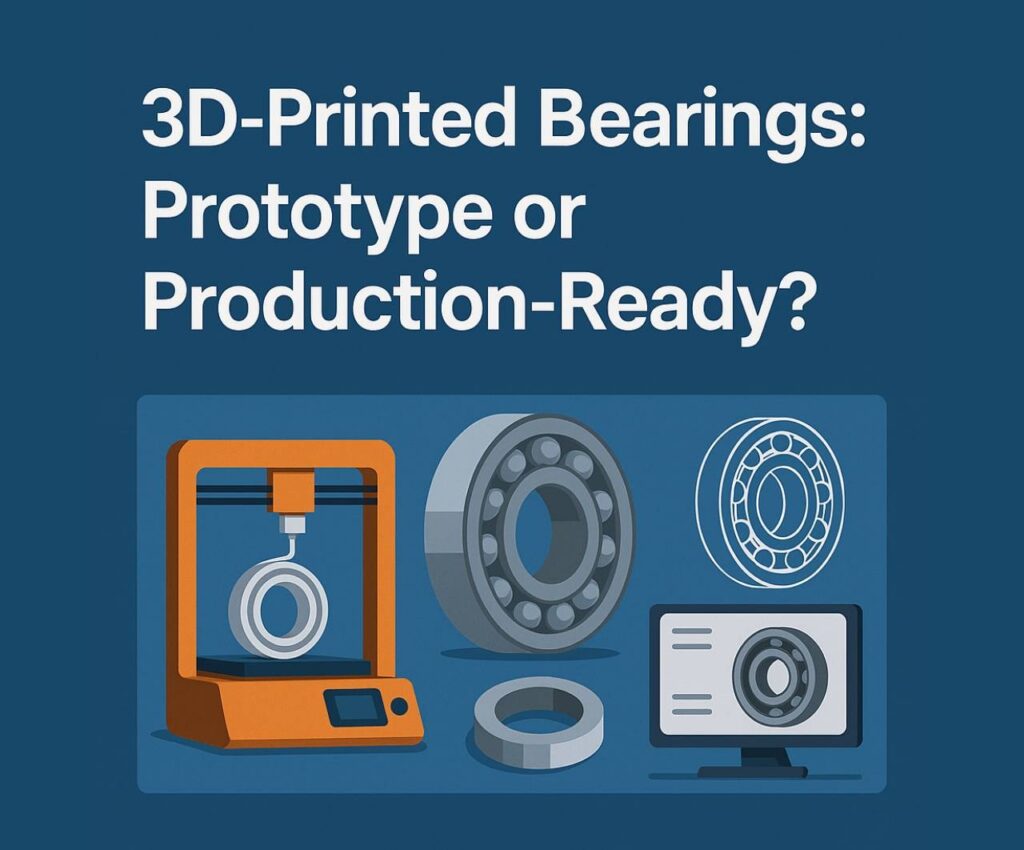The world of 3D printed bearings, additive manufacturing in engineering, and custom bearing solutions is expanding fast. What was once seen as a novelty for prototyping is now pushing into production lines, aerospace assemblies, and even medical devices. But where’s the line between experimental and everyday use? Can 3D printed bearings really match traditional metal or ceramic components in durability and performance? Or are they still stuck in the sandbox of rapid prototyping?
This article dives into the real-world applications, surprising benefits, and hard limitations of 3D printed bearings, and where they’re headed in the future of mechanical design. Know More
What Are 3D-Printed Bearings, Exactly?
3D printed bearings are exactly what they sound like—bearing components manufactured layer by layer using additive manufacturing in engineering instead of traditional machining, molding, or forging. These can be bushings, ball-bearing races, cages, or entire integrated units depending on the complexity and material used.
The materials vary from high-strength polymers to advanced metal alloys and even hybrid designs combining multiple elements. But the core idea is the same: create custom bearing solutions faster, cheaper, and in more complex geometries than previously possible.
The Prototype Advantage
At the prototyping stage, 3D printed bearings are game-changing. Engineers can:
- Test different clearances and tolerances quickly
- Validate fit in complex assemblies
- Explore non-standard shapes for custom housings
Traditional bearings have standard sizes and limits. But with additive manufacturing in engineering, there’s no need to design around what’s available—you design exactly what’s needed. This opens the door to custom bearing solutions tailored to specific loads, temperatures, or spatial constraints.
But Can They Handle the Heat (Literally)?
Let’s be clear: 3D printed bearings aren’t always production-ready. Especially under high loads, high speeds, or extreme environments, traditional machined bearings still dominate.
Here’s where 3D printed bearings currently struggle:
- Load capacity: Polymer-based bearings can deform under high loads unless reinforced.
- Surface finish: Roughness increases friction unless post-processed or printed with high-resolution systems.
- Thermal resistance: Standard 3D printing materials often have lower thermal tolerance than steel or ceramic.
However, the gap is closing. New materials like PEEK, Ultem, and metal matrix composites are improving performance. In high-performance additive manufacturing in engineering, laser-sintered titanium or stainless-steel bearing races are already in low-volume aerospace production.
Real-World Use Cases
1. Medical Devices
Custom surgical tools or robotic arms often use custom bearing solutions that fit tight or irregular spaces. Here, 3D printed bearings provide frictionless motion with sterilizable, biocompatible polymers.
2. Aerospace & Drones
Weight is everything. Metal bearings can be replaced with lighter 3D printed bearings using advanced plastics or hollow structures—without compromising functionality.
3. Robotics & Prototyping
In soft robotics or early-stage development, speed matters. Engineers turn to additive manufacturing in engineering for fast iteration cycles. Bearings are integrated directly into arms, joints, or wheels.
4. Motorsports
Some racing teams are testing custom bearing solutions for specific tracks or cars—tuning the internal design of the bearing itself using 3D printing to match vibration patterns or shock loads.
Integration with Other Printed Parts
Here’s where things get exciting. What if the bearing isn’t a separate part—but integrated into the product itself?
Additive manufacturing in engineering enables printing bearing surfaces directly into other components. For example:
- A drone’s propeller housing with built-in 3D printed bearings
- A gearbox with embedded bearing channels
- A wearable device with rotating parts made in a single print
This is the frontier of custom bearing solutions—not just printing a bearing, but rethinking how and where bearings live in a product.
Post-Processing: The Missing Link
One of the biggest differences between 3D printed bearings and traditional ones is surface finish. Bearings require precision surfaces to reduce friction and wear. Here’s how that’s handled:
- Smoothing via machining: Often, races or inner rings are machined after printing for better tolerance.
- Infiltration or coating: Applying low-friction polymers or lubricants post-print to enhance performance.
- Hybrid builds: Some use a printed cage or housing but insert metal balls or races for durability.
So while you can 3D print a full bearing, many high-stress applications still rely on custom bearing solutions that blend traditional parts with printed structures.
Environmental Impact: A Greener Alternative?
3D printed bearings offer sustainability perks. Less material waste, no need for machining fluids, and the ability to print locally (reducing shipping emissions) make additive manufacturing in engineering a cleaner process overall.
Also, because bearings can be made to order, there’s less overproduction and storage waste. That’s a big deal in industries pushing for greener supply chains.
Barriers to Widespread Adoption
Despite the innovation, 3D printed bearings aren’t mainstream—for good reason:
- Certification issues: Aerospace, automotive, and medical industries have strict part approval processes.
- Repeatability: Ensuring consistent quality across batches is harder with 3D printing than with CNC machining.
- Cost at scale: For mass production, traditional methods are still cheaper per part.
Still, as technology matures and custom bearing solutions become more normalized, those barriers will continue to shrink.
What the Future Holds
We’re heading toward a world where 3D printed bearings are designed digitally, tested in virtual simulation, printed on-site, and installed the same day. Supply chains collapse from months to hours. Repair becomes more about downloading a file than waiting for a shipment.
Add AI to the mix, and additive manufacturing in engineering could optimize bearing designs on the fly—based on specific machine behavior, environmental conditions, or use case.
So—Prototype or Production-Ready?
Here’s the verdict:
- For prototyping: 3D printed bearings are absolutely ready. They slash time, cost, and design limitations.
- For niche production: In lightweight, low-load, or highly customized applications, they’re already being used.
- For mainstream use: Not quite yet—but fast approaching. With stronger materials, better printers, and tighter QC, custom bearing solutions will soon challenge traditional parts.
As the field of additive manufacturing in engineering evolves, so too will the bearing. And the question won’t be “can we 3D print a bearing?”—it’ll be “why would we make one any other way?”

